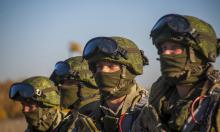USA shows 'Keen Sword' to China and North Korea
 December 3 marked the start of Keen Sword military exercises began near the island of Okinawa, the largest military training in the history of US-Japan military exercise. Their goal is practicing Japan's defense "against foreign aggression." The event has already caused considerable frustration not only in Korea but also in China.
December 3 marked the start of Keen Sword military exercises began near the island of Okinawa, the largest military training in the history of US-Japan military exercise. Their goal is practicing Japan's defense "against foreign aggression." The event has already caused considerable frustration not only in Korea but also in China.

These countries link the training to the recent incident with North Korean artillery shelling the South Korean island Enphendo. Meanwhile, Tokyo and Washington refer to the fact that they have been holding them on a regular basis every two years since 1986.
However, it is worth mentioning that initially they tried to hold the training in the Sea of Japan, aiming to reflect a possible Soviet attack on the Land of the Rising Sun. Now they have shifted to the south. Although the defense departments of both countries state that the exercises are not directed against third countries, Japanese media writes that the maneuvers should show solidarity in the face of heightened threat from the Korean peninsula.
In addition, China and the DPRK cannot but worry about the fact that the U.S. and Japan have significantly broadened the scope of the exercise. If previously no more than 25 thousand people, 20 warships and 300 aircraft participated in the maneuvers, now the training involves 44,000 people, 60 warships and 400 aircrafts.
During the recent maneuvers the Americans have successfully implemented innovative network CENTRIX, thanks to which the military of the two countries have no problems in communicating with each other.
Through conducting these exercises, the US-Japan military cooperation is gradually expanding. If in 2001 the maneuvers during Keen Sword were comprised mainly of rescue operations, now the main stated objective is, among others, the "establishment of interaction between the defense of Japanese Self-Defense Forces (JGSDF) with the Navy, Air Force and U.S. Marine Corps.
Of course, this cannot but cause frustration of the Chinese and North Korean military experts. They believe that the actions of the Japanese and U.S. military threaten the interests of China and the DPRK.
Their fears can be understood. Military analysts say that Americans and Japanese are clearly working out amphibious landings on the mainland. According to the legend of the teachings, they confront the superior forces of enemy aircraft trying to break through to U.S. warships and Japan. China is perhaps the only country that has the Air Force capable of doing this in the region.
The Americans do not hide the fact that Keen Sword is preserved as a legacy of the Cold War, when Uncle Sam practiced the defense of Japan against possible "Soviet aggression." But now the protection from possible enemy attacks for some reason has to include military operations in the Korean peninsula.
The North Korean press, particularly the Rodong Sinmun newspaper, said that by doing so, the Americans are preparing for a preventive strike on North Korea. In addition, Pyongyang drew attention to some other maneuvers regularly conducted here. We are talking about the US-South Korean military exercise Foal Eagle.
In North Korea, Foal Eagle and Keen Sword are considered to be the "links of the same anti- Pyongyang chain." The country believes that the U.S. plans, in case of an aggravation, to act against it in the coalition with South Korea and Japan. Until now, it was prevented by one "but." The relations between Seoul and Tokyo, of course, are much better than the relations between Tokyo and Pyongyang. However, they are problematic enough, if we recall the historical dispute between Japan and South Korea about a number of islands in the Sea of Japan.
However, apparently, now the North Korean threat brought Tokyo closer with Seoul. At least the Americans had made sure that representatives of South Korea are solidly represented in these maneuvers as observers.
However, China's position deserves special attention. Its discontent is rooted in the fact that, according to some military experts, the probable beginning of a war against North Korea is a part of the new U.S. strategy to maintain the U.S. position in the region and deter the growing Chinese threat.
Of course, this is not 1950, and it is unlikely that millions of Chinese volunteers would rush to help in the event of a war against North Korea, as they did under Mao Zedong. However, there is no doubt that China will not stand by idly and silently watch as the Americans and their satellites eliminate "the North Korean buffer zone" and install a puppet regime in Pyongyang. At the very least, Beijing will help it with fuel supplies, which are desperately needed by the North Korean armed forces, and new models of military equipment, especially when it comes to the defense.
Sergei Balmasov
Pravda.Ru
Subscribe to Pravda.Ru Telegram channel, Facebook, RSS!


